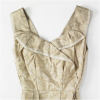MissV57
Registered Guest
Hi Everyone!
I bought this lovely top which was marked as 1940s. However some elements make me think it is not and some that it is ! So confused
It has both back and side zipper. Zipper is Opti but it does not look metal to me. It is hand made. Sewing is left frayed. No shoulder pads (at least none left)
I have attached pictures!
Thank you so much
I bought this lovely top which was marked as 1940s. However some elements make me think it is not and some that it is ! So confused
It has both back and side zipper. Zipper is Opti but it does not look metal to me. It is hand made. Sewing is left frayed. No shoulder pads (at least none left)
I have attached pictures!
Thank you so much

Attachments
-
 20200322_134346.jpg43.6 KB · Views: 431
20200322_134346.jpg43.6 KB · Views: 431 -
 20200322_134403.jpg59.8 KB · Views: 437
20200322_134403.jpg59.8 KB · Views: 437 -
 20200322_134512.jpg61.6 KB · Views: 460
20200322_134512.jpg61.6 KB · Views: 460 -
 20200322_134735.jpg50.9 KB · Views: 424
20200322_134735.jpg50.9 KB · Views: 424 -
 20200322_134509.jpg53.9 KB · Views: 438
20200322_134509.jpg53.9 KB · Views: 438 -
 20200322_134441.jpg51.5 KB · Views: 411
20200322_134441.jpg51.5 KB · Views: 411 -
 20200322_135926.jpg51.8 KB · Views: 400
20200322_135926.jpg51.8 KB · Views: 400 -
 20200322_140840.jpg56.4 KB · Views: 448
20200322_140840.jpg56.4 KB · Views: 448
 .
.




















